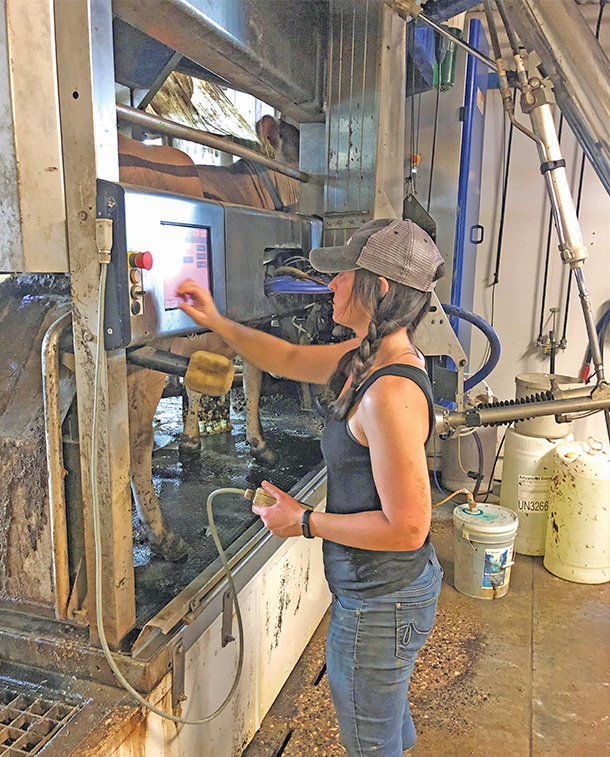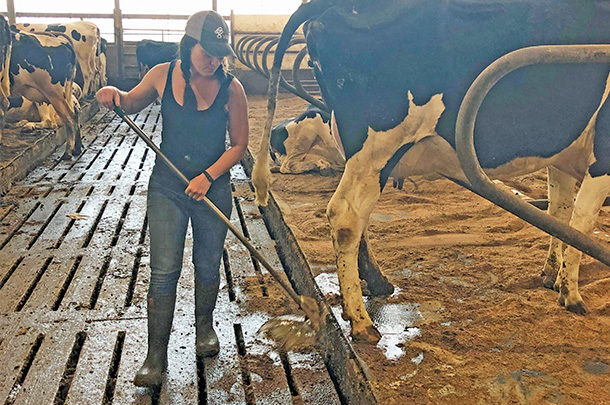From sunup to sundown, I get to live my passion of working with cows and dairy farmers as an education specialist with VAS. Every day for me centers around using DairyComp herd management software to facilitate discussions and trainings and teach others how to use it – including farmers, veterinarians, nutritionists, dairy herd improvement technicians and A.I. technicians.
I’m based in Wisconsin, but any given day you could see me traveling across the U.S. along with my counterpart, Craig Walter. We co-facilitate many trainings and often team up for university presentations. His extensive DairyComp knowledge paired with my cowside knowledge makes us a great team.
On weekends, I work as a herdsperson for a local dairy. My husband and I have a hobby farm, and I also own a small dairy herd. Being on the farm gives me life and energy in my day job and keeps me grounded in day-to-day farm management practices.
 Taliah Danzinger makes cow data easier to use and understand as a VAS education specialist. On weekends, she works as a herdsperson for a local dairy. Courtesy photo.
Taliah Danzinger makes cow data easier to use and understand as a VAS education specialist. On weekends, she works as a herdsperson for a local dairy. Courtesy photo.
A love for teaching
I’ve always loved teaching, and my current role allows me to use those skills every day. A typical week could include walking a herd, facilitating on-farm meetings, reviewing data one-on-one, trainings, teaching at a university, answering software questions and taking phone calls.
I’m in a unique third-party role where I advise on numbers. I care what the cows tell us through data and how it can help us create a sustainable future for the farm.
On a day when I’m teaching about dairy at a university, I talk about how to use data, how to use a herd summary or other report and work through case studies with the students. I enjoy teaching using case studies to help students draw parallels between the data on paper and what is actually happening on the farm.
In between, I take a lot of phone calls on numbers and data. Common questions are: “Can you look this up?” “What’s happening here?” I log in to DairyComp on my computer, and with a few key commands I usually can answer the questions with a quick screenshot. If I’m away from my computer, I use the software’s phone app to view the data.
Some days I perform internal training. I’m often training our milk testing technicians, as they’re using DairyComp to input milk test day data and sometimes herd management data (if the farm isn’t doing it on their own). In my trainings, I explain how our data works and how to get good data integrity – we only get good data out if we put good data in. I tell them how accuracy in their job is literally life or death for cows – if they enter the wrong data, it can cause a shift in a cow’s career from milking cow to beef.
Identifying opportunities
As I’m facilitating on-farm meetings, I talk through specific KPI values and trends that I find would be most helpful for the farm. I use DairyComp and the software’s milk testing reports to help show what the data is saying and guide my conversation. As questions come up, I dig into more data to verify or direct our discussion.
I also help farmers use their data to make comparisons and identify improvement opportunities using benchmarks. I like to make comparisons using our profit opportunity analyzer, which compares the farm to peers by breed or herd size. The analyzer ties real dollars to the data once I input what the farm receives for its mailbox milk price, cull cows and replacement animals. I compare the farm’s data to the 80th percentile of the peer group. If management areas are far off in the comparison, I work with the farmer to consider if a change could be profitable and something they want to tackle.
Alternatively, I compare the herd to itself. Maybe the data reveals udder health is declining. Then, I dig in and investigate: Where are the sources of infection? What changed? When did it start? Is it a protocol issue, environmental or something else?
My job is to ask a lot of questions. I’m always asking more questions than I’m giving feedback. And asking questions is how I investigate. If the data tells me something, I need to figure out the root and work toward a solution.
Managing through change
Helping farms transition through big changes with minimal disruption is another part of my day-to-day life. Each day could see me helping a farm transition to a new parlor or robotic milking, plan for expansion, shift from a purebred to a crossbred herd, make ration or personnel changes and more.
I’m also fortunate to work each day with families as they pass the torch to the next generation. That’s meaningful to me because the work we’re doing to keep the farm profitable means they’re able to transition it to the next generation. For me, it’s really serious because I have a big role as a third party and extra set of eyes in helping protect the farm and ensure things don’t slip in transition.
If I can accomplish one thing in my day, it’s knowing I’ve helped a farmer affirm they’ve made the right decision. And that I’ve given them the confidence to stay the course or change directions. There are so many unknowns in farming. If I can help make something known, then I feel a sense of accomplishment.





